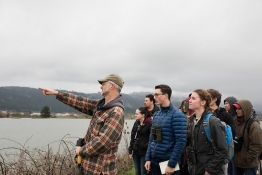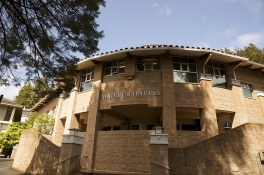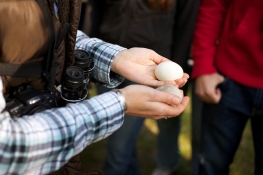Matthew Johnson
Research Interests
Habitat Ecology...a unifying theme
I am fascinated by all aspects of wildlife Habitat Ecology - from the theoretical to the practical. Habitat ecology is the study of how animals interact with their habitats, which my lab investigates by identifying animals' critical resources and the factors that constrain their use. Such studies advance our ecological understanding and refine our conservation and management efforts. I purposefully work with a variety of taxa to better understand emergent relationships between animals and their habitats. Therefore, students in my lab work on a diversity of study systems, yet share a unified focus on habitat.
Learn more about my lab's research
Current & former graduate students in the lab
Top-cited Publications
- 2007 Johnson, M.D. Measuring habitat quality: a review. Condor 109:489-504 PDF
- 2011 Wenny, D., T.L. DeVault, M.D. Johnson, D. Kelly, C.H. Sekercioglu, D.F. Tomback, and C.J. Whelan. The need to quantify ecosystem services provided by birds. Auk 128: 1-14. PDF
- 2001 Johnson, M.D. and T.W. Sherry. Effects of food availability on the distribution of migratory warblers among habitats in Jamaica, West Indies. Journal of Animal Ecology 70:546-560 PDF
- 2008 Kellermann, J.L., M.D. Johnson, A.M. Stercho, and S. Hackett. Ecological and economic services provided by birds on Jamaican Blue Mountain coffee farms. Conservation Biology 22:1177-1185 PDF
- 2006 Johnson, M.D., T.W. Sherry, R.T. Holmes, and P.P Marra. Assessing habitat quality for a migratory songbird wintering in natural and agricultural habitats. Conservation Biology 20:1433-1444. PDF
Inclusive Excellence
In recent years, my professional work at Cal Poly Humboldt has increasingly emphasized inclusive excellence in Science, Technology, Engineering, and Math (STEM) education.
Read about my work for inclusive excellence
Interested in joining the lab?
If you share some of my research interests (see research below) and would like to inquire about being a part of my graduate lab, there are a few steps you can take to let me know of your interest. Understand that space is limited and competition can be strong; I typically only accept 1-3 new students per year from among top candidates (see my current students). Successful applicants send me a sample of their writing in a 1-2 page thesis project idea proposal via email along with a CV and references (matt.johnson@humboldt.edu). Be sure to also mention possible funding sources if you have them. If I have space and we share interests, you may also want to arrange for a visit to the Humboldt campus. If requested, you will send a formal application to the Graduate School
Courses Taught
Awards & Recognition
- California State University, Faculty Innovation and Leadership Award, with Dr. Amy Sprowles. 2020.
- Fulbright Scholarship to India. 2013.
- Humboldt Scholar of the Year. 2010.
- Alistair McCrone Promising Young Scholar Award. 2004.
- Cooper Ornithological Society A. Brazier Howell Award for outstanding presentation. 1999.
- Southern Graduate Student Biological Symposium Award for Outstanding Presentation. 1998.
- Louisiana Educational Quality Support Fund Graduate Fellowship. 1993-1997.
- U.S. Forest Service Award for work on Neotropical Migrant Habitat Summaries. 1992.
- U.S. Forest Service Award firefighting. 1992.
- President’s Award for Outstanding Freshmen, UC Davis. 1988.
Professional Service, Memberships & Activities
- The Wildlife Society, Society for Conservation Biology, American Ornithologists' Union, Cooper Ornithological Society.
- Regular reviewer of papers submitted to Auk, Condor, Conservation Biology, Journal of Wildlife Management, Journal of Animal Ecology.
- Reviewer for National Science Foundation
- Board member, Friends of the Dunes
- Science Chair, Cooper Ornithological Society annual meeting, June 2005.
Grants
- Since 2000, I have been the Principle Investigator or co-Principle Investigator on grants and contracts totaling over $9 million.
- We’ve received grants from a variety of funders, including the National Science Foundation, US Dept of Agriculture, US Dept of Education, Howard Hughes Medical Institute, the Agricultural Research Initiative, and the National Geographic Society.
Education
Current Graduate Students
| Name | Thesis |
|---|---|
Tiana Williams-Claussen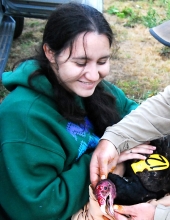 |
A Case Study in Integrating Federal, Tribal, and State Legislation to Support Northern California Condor Restoration Tiana is conducting intersectional analysis of the conservation of prey-go-neesh, or California Condors, in the North Coast of California. Specifically, her project will seek to review and analyze the 19-year journey toward successful reintroduction of prey-go-neesh to Yurok ancestral... Read Tiana's bio |
Ayla Zolwik |
Analyzing Swainson’s hawk movement & behavioral ecology in response to the California high-speed rail construction throughout the Central Valley I graduated from the University of British Columbia in Vancouver, receiving my Bachelor of Science degree in Natural Resources Conservation through the Faculty of Forestry. Since then, I have been working seasonal technician positions throughout the United States and Canada focusing primarily, but... Read Ayla's bio |
D. Mac Wilson |
Bird, bee, and bat community composition on licensed cannabis farms in Humboldt County, California and responses to hedgerow habitat enhancements I graduated from Rhodes College in Memphis, TN in 2017, and later worked on several wildlife projects, gaining interest in wildlife and working landscape in general, and the impacts of cannabis cultivation in particular. I joined the lab in 2022, and I am interested incorporating more community... Read D. Mac's bio |
Ximena Gil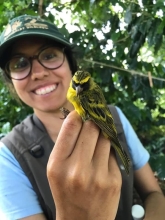 |
Do rangeland management practices incentivized by California's Healthy Soils Program confer co-benefits for both birds and ranchers? Ximena will be investigating land management practices on rangelands within Point Blue Conservation's Range Monitoring Network. Specifically, she will attempt to understand the potential co-benefits for grassland bird species from Healthy Soils practices by using a newly described "Bird-... Read Ximena Gil's bio |
Jadzia Rodriguez |
Effects of vegetation on the behavior of hunting barn owls (Tyto furcata) and their prey Jadzia is studying how changes in habitat and vegetation affect the behavior of hunting barn owls and their prey. She is interested in how these altered behaviors could affectthe outcome of a predator-prey interaction. In the spring and summer of 2024, Jadzia deployed GPS tags fitted with... Read Jadzia's bio |
Eleanor MacDonald |
Examining the effects of songbird nest boxes on ecosystem services and avian community composition in Napa Valley vineyards Eleanor is investigating how the addition of nest boxes affects bird communities and whether this has any top-down effect on insects in Napa Valley winegrape vineyards. Her project focuses on winegrape vineyards that lie along gradients of local habitat and landscape complexity and will also... Read Eleanor's bio |
Lauren Jackson |
How does personality influence the hunting behavior and potential for ecosystem services provided by barn owls in an agroecosystem? Lauren is from Central Oregon, where she originally found her passion for wildlife and exploring the outdoors. She developed a love for ornithology and avian research during her undergraduate studies at McGill University, and has continued to work with birds ever since. Her master’s thesis work is... Read Lauren's bio |
Christian Cortez |
Physiological conditions of barn owl (Tyto furcata) nestlings as indicators of habitat quality within the wine-growing region of Napa Valley Christian will be assessing several physiological conditions of barn owl nestlings from nest boxes to investigate the effects of nearby land cover on their health. These physiological conditions include feather growth bars, fault bars, heterophil-lymphocyte ratios, and corticosterone levels in... Read Christian's bio |
Elizabeth Meisman |
Testing Adaptive Flexibility in Breeding Swainson’s Hawk Territory Habitat Selection Lizzi will be investigating potential mismatches between habitat quality and selection in Swainson's Hawks (Buteo swainsoni) in Northern California. In long-lived territorial species like Swainson’s Hawks, these mismatches may pose serious risk to population viability. One of the longest... Read Elizabeth's bio |
Dabid Garcia |
Testing Vegetation Composition as a Predictor of Soil Organic Carbon on Working lands in California Using a Voluntary Monitoring Network Dabid will be analyzing vegetation composition and soil core data collected from many ranches across California to look for correlations between plant species composition and soil organic carbon. On working lands, vegetation composition has the potential to alter the amount of carbon being... Read Dabid's bio |
Fatime Jomaa |
The use of social information for prospecting and nest site selection by Western Bluebirds (Sialia mexicana) Fatime will be examining methods that may accelerate songbird nest box occupancy in agricultural systems. She will investigate whether prospecting Western Bluebirds use social information to select nest sites in Napa Valley vineyards by broadcasting signals that simulate conspecific presence and... Read Fatime's bio |
Former Graduate Students
| Name | Thesis |
|---|---|
|
Jaime Carlino 2024  |
Measuring barn owl breeding habitat quality and predicting double brooding Jaime evaluated multiple measures of habitat quality in order to identify areas of high quality barn owl breeding habitat in Napa Valley and inform which measures can be reliably used in other areas. Her research also aimed to reveal potential mismatches between observed habitat preferences and... Read Jaime Carlino's bio |
|
Maddie Ybarra 2024  |
The effects of native perennial cover on avian physiological indicators of habitat quality in California coastal prairie rangelands. Maddie investigated the physiological responses to native perennial cover for two grassland bird species, Grasshopper Sparrow (Ammodramus savannarum) and Savannah Sparrow (Passerculus sandwichensis). Specifically, she used leukocytes (white blood cells) and body condition to assess... Read Maddie Ybarra's bio |
|
Katherine Larson 2024  |
Barn owls exert top-down effects on the abundance and behavior of rodent pests Katherine is investigating how predator-prey interactions affect ecosystem services on Napa Valley vineyards. More specifically, she using is monitoring blocks to determine if barn owls meaningfully reduce vole and mouse abundance, and she is using giving up density (GUD) trays to determine if barn... Read Katherine Larson's bio |
|
Laura Echávez 2023  |
Polymorphism of barn owls in a managed ecosystem From dark reddish to crisp white, and from heavily spotted to almost no spots at all, barn owls can exhibit a wide range of plumage coloration. In other regions, Barn owls have been shown to associate with different foraging areas based on their coloration, and this affects which rodents they hunt... Read Laura Echávez's bio |
|
Samantha Chavez 2023  |
Maximizing the use of a natural avian predator for pest control in an agricultural system Samantha is interested in how the composition and configuration of land cover types – such as vineyards, grasslands, and oak savannahs -- can affect Barn Owl nest box occupancy and the areas they hunt in. She used spatial models to predict the hunting pressure owls exert on a landscape as a... Read Samantha Chavez's bio |
|
Ashley Hansen 2022  |
Use of an avian predator as a biological control agent in agricultural systems: Do barn owls (Tyto alba) impact rodent abundance in a vineyard setting? Ashley studied how barn owls impact rodent populations within Napa Valley vineyards. Over the barn owl breeding season, she compared rodent populations and their activity in vineyards with and without barn owl boxes. She found that the presence of barn owl nest boxes significantly reduced gopher... Read Ashley Hansen's bio |
|
Frank Juma Ong'ondo 2021  |
Bird abundance and diversity in shade coffee and natural forest in Kenya After Humboldt, Frank went on to pursue a PhD at Mississippi State University. For his thesis, Frank investigated how shade coffee can harbor forest-associated species of birds in Kenya. Previous research has shown that coffee farms in the Neotropics can provide good habitat for birds, but it... Read Frank Juma Ong'ondo's bio |
|
Deven Kammerichs-Berke 2020  |
Foraging selectivity of insectivorous birds in Kenyan shade coffee systems After Humboldt, Deven went on to work as a wildlife biologist in southern California. For his thesis, Deven studied the effects of shade tree species in Kenyan coffee farms on insectivorous bird foraging behavior. Specifically, his research looked at whether Cordia africana (a tree indigenous... Read Deven Kammerichs-Berke's bio |
|
Brooks Estes 2019 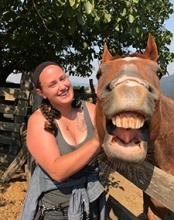 |
Farmer perceptions of barn owls as part of integrated pest management in vineyard ecosystems. A student of the Environment & Community MA program, Brooks’s research focused on the knowledge and attitudes of Napa Valley wine producers regarding integrated pest management techniques, and their views on conservation issues in general. She completed a mixed-methods project, sending surveys... Read Brooks Estes's bio |
|
Allison Huysman 2019  |
Barn owl hunting responses to wine country wildfires. After Humboldt, Allison went on to work as a research associate at Georgetown University and the Smithsonian Migratory Bird Center. For her thesis, Allison studied barn owl response to wildfires in Napa Valley by monitoring nest boxes and placing GPS transmitters on owls. She used this... Read Allison Huysman's bio |
|
Dane St. George 2019  |
Barn owl prey delivery rates in Napa Valley vineyard ecosystems. After Humboldt, Dane went on to be a wildlife biologist with the California Dept of Fish and Wildlife. For his thesis, Dane studied barn owl prey delivery in winegrape vineyards in Napa Valley. Using nest box cameras, he documented the rate at which adults deliver prey items to birds in the... Read Dane St. George's bio |
|
Dawn Blake 2018  |
Foraging habitat of pileated woodpeckers in relation to a managed landscape on the Hoopa Valley reservation, Northwestern California After Humboldt, Dawn worked as a wildlife biologist for the Hoopa Valley Tribe. For her thesis, Dawn used radio telemetry to track the movements and document habitat selection of Pileated Woodpeckers on the Hoopa Valley Reservation. This work is significant because the species is generally... Read Dawn Blake's bio |
|
Xerónimo Castañeda 2018  |
Quantifying habitat use by barn owls foraging in vineyards versus adjacent habitats. After Humboldt, Xerónimo went on to work for California Audubon. For his thesis, Xerónimo studied barn owl habitat use within a vineyard agroecosystem by quantifying the extent of time barn owls spend hunting within vineyards versus adjacent habitats. He also collected data on the owls’... Read Xerónimo Castañeda's bio |
|
Shannon Mendia 2016  |
Examining ecosystem services and disservices of bear damage on Hoopa Valley Reservation After Humboldt, Shannon continued to work as a wildlife biologist for Hoopa Valley Tribal Forestry, and then on to the US Forest Service Pacific Southwest Research Station.For her thesis, Shannon examined the relationship between bear damage to trees and bird community composition and structure (... Read Shannon Mendia's bio |
|
Jennifer Brown 2016  |
Effects of canopy cover on the prevalence of Batrachochytrium dendrobatidis on frogs in Jamaican coffee farms. After Humboldt, Jen went on to work as a veterinary technician in Humboldt County, and then as a wildlife technician with the Yurok Tribe. For her thesis, Jennifer examined the incidence and prevalence of a disease-causing fungus on frogs in coffee farms in Jamaica. Batrachochytrium... Read Jennifer Brown's bio |
|
Carrie Wendt 2016  |
Examining barn owl nest box selection at three spatial scales on Napa Valley vineyards After Humboldt, Carrie went on to work as a partner biologist for the Natural Resource Conservation Service and Point Blue Conservation Science. For her thesis, Carrie studied the nest box and habitat characteristics that predict barn owl nest box occupancy on winegrape vineyards in Napa,... Read Carrie Wendt's bio |
|
Wendy Cristina Willis 2015  |
Perceptions of shade tree cultivation by coffee farmers in the Blue Mountains of Jamaica After Humboldt, Wendy went on to work for the American Bird Conservancy and then to be Director of Jocotoco USA, an Ecuadorian conservation NGO For her thesis in Humboldt's Environment & Community MA program, Wendy used an interdisciplinary approach to investigate how political,... Read Wendy Cristina Willis's bio |
|
Chris Smith 2014  |
Bird species richness and abundance in shade and sun coffee farms in Kenya After Humboldt, Chris went on to work as a field ornithologist in Australia and New Zealand. Chris studied the effects of shade trees in Kenyan coffee farms on bird abundance and species richness. Virtually no research had been done in coffee on bird communities in Africa, and it was... Read Chris Smith's bio |
|
Stephanie Eyes 2014  |
The effects of fire severity on California spotted owl habitat use patterns After Humboldt, Stephanie went on to work for US Forest Service. For her thesis, Stephanie examined how fire severity affects patterns of California spotted owl (Strix occidentalis occidentalis) habitat use in Yosemite National Park. She used radio telemetry to monitor a population of spotted... Read Stephanie Eyes's bio |
|
Megan Milligan 2014  |
Quantifying pest control services by birds in Kenyan coffee farms After Humboldt, Megan went on to work as an ornithologist at Hastings Natural History Reservation and then on to earn a PhD at Montana State Unversity. For her thesis at Humboldt, Megan studied avian predation in Kenyan coffee farms and examined how pest control is influenced by the local... Read Megan Milligan's bio |
|
Megan Garfinkel 2013  |
Pest-removal services provided by songbirds on small organic farms in Humboldt County, CA After Humboldt, Megan went on to earn a PhD at University of Illinois at Chicago. For her Humboldt thesis, Megan studied songbird populations on organic row crop farms in order to answer the questions: do insectivorous songbirds provide a top-down effect on row crops by providing pest-removal... Read Megan Garfinkel's bio |
|
Ryan Kalinowski 2012  |
Habitat relationships of great gray owl prey in meadows of the Sierra Nevada Mountains After Humboldt, Ryan went on to work as a Wildlife Biologist for the US Forest Service in the Sierra Nevada. For his thesis, Ryan quantified the habitat relationships of Great Gray Owl prey in California montane meadows. More specifically, he investigated the influence of vegetative... Read Ryan Kalinowski's bio |
|
Brent Campos 2012  |
Habitat selection, habitat use, and home ranges of black-throated blue warblers on Jamaican coffee farms: implications for an ecosystem service After Humboldt, Brent when on to work for point Blue Conservation Science. For his thesis, Brent studied the movements and habitat associations of black-throated blue warblers (Dendroica caerulescens) in and around Jamaican coffee farms. His research elucidated how the provisioning of a known... Read Brent Campos's bio |
|
Sacha Heath 2011 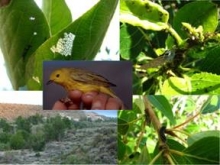 |
The effects of bird and bat arthropod predation on sapling black cottonwoods in the context of restoration After Humboldt, Sacha went on to earn a PhD at University of California at Davis. For her Humboldt thesis, Sacha thought about ways in which birds contribute to the restoration of their own breeding habitat. She approached one aspect of this broader question by investigating whether... Read Sacha Heath's bio |
|
Marlene Wagner 2011  |
Habitat selection by red-breasted sapsucker (Sphyrapicus ruber) in southeast Alaska old-growth forest After Humboldt, Marlene went on to earn a PhD at Simon Fraser University. For her Humboldt thesis, Marlene’s study provided information on how Red-breasted Sapsuckers, a keystone species and ecological engineer, are distributed in wilderness forests and what habitat covariates are important... Read Marlene Wagner's bio |
|
Jared Wolfe 2009  |
Habitat use of Nearctic-Neotropic migrant birds in northeastern Costa Rica After Humboldt, Jared went on to earn a PhD at Louisiana State University and then become a faculty member at Michigan Technological University. For his Humboldt thesis, Jared studied migrant stopover ecology in Northeastern Costa Rica. More specifically, his work utilized banding data,... Read Jared Wolfe's bio |
|
Jeanne Hammond 2008  |
Nest predation at the Cosumnes River Preserve: Is an introduced predator, the black rat (Rattus rattus), limiting songbird breeding productivity? After Humboldt, Jeanne continued to work for PRBO Conservation Science. For her thesis, Jeanne’s conducted an experiment to determine whether an introduced predator, the black rat, limits Song Sparrow nesting productivity. Nesting success in mature riparian forest is very low due to predation... Read Jeanne Hammond's bio |
|
Amy Roberts 2008  |
Bat use of redwood basal hollows with increasing isolation in contiguous, remnant, and legacy redwood forest stands. After Humboldt, Amy worked for the EPA in Sacramento. Fr her thesis, Amy investigated how roost isolation and distribution may affect bats' use of redwood basal hollows located in Redwood National Park and adjacent private land. She used guano-traps placed within hollows to determine the use... Read Amy Roberts's bio |
|
Dominic Bachman 2008  |
Aleutian Cackling Goose Habitat Management [co-advised with Dr. Jeff Black]. After Humboldt, Dominic worked for US Fish and Wildlife Service in Alturas, CA. For his thesis, Dom conducted an experiment to identify management practices that may attract geese to public grasslands. Specifically, he tested fertilizer versus clover cultivation as a means to provide abundant... Read Dominic Bachman's bio |
|
Rebecca Green 2007  |
Distribution of forest carnivores and evaluation of habitat models for American Marten in Sequoia and Kings Canyon National Parks. After Humboldt, Rebecca went on to earn a PhD at UC Davis. For her Humboldt thesis, Rebecca investigated the distribution of American marten, fisher and other medium-sized carnivores in a variety of habitats and elevations in the southern Sierra Nevada mountains. Track plates and remote... Read Rebecca Green's bio |
|
Amy Leist 2007  |
The importance of fruit to Swainson’s thrushes, Catharus ustulatus, at stopover sites during fall migration: A field test of plasma metabolite analysis. After Humboldt, Amy worked for the Great Basin Bird Observatory. For her thesis, Amy used blood metabolite analysis to determine if migrating Swainson’s Thrushes selecting habitats rich in food were feeding more effectively than those selecting habitats with fewer fruits. The concentrations... Read Amy Leist's bio |
|
Jherime Kellermann 2007  |
Assessing an economic incentive for bird-friendly coffee cultivation in Jamaica, West Indies. After Humboldt, Jherime went on for a PhD at the University of Arizona, and then on to be a professor at the Oregon Institute of Technology. For his Humboldt thesis, Jherime’s project focused on “ecological services” provided birds in an agricultural setting. He used experimental cages... Read Jherime Kellermann's bio |
|
Eric Wood 2007  |
Predictive modeling of focal bird species in Central Sierra Nevada Foothill woodlands. After Humboldt, Eric went on for a PhD at the University of Wisconsin and then on to be a professor at Cal State LA. For his Humboldt thesis, Eric used state-of-the-art presence/absence occupancy modeling to examine habitat relationships of songbirds in blue oak woodlands. He tested the... Read Eric Wood's bio |
|
Jim Tietz 2006  |
Stopover ecology and habitat selection in fall migrant Swainson’s Thrushes (Catharus ustulatus) along the northern California coast. After Humboldt, Jim worked for PRBO Conservation Science. For his thesis, Jim used using radio telemetry to track migrating thrushes in forested habitats of the Lanphere Dunes near Arcata. He tested whether the birds select vegetation primarily in response to habitat structure (shrub density... Read Jim Tietz's bio |
|
Chris Tonra 2006  |
Hatching Synchrony in Brown-Headed Cowbirds: The influence of host density, chick gender, and habitat. After Humboldt, Chris went on for a PhD at University of Maine and then on to be a professor at The Ohio State University. For his Humboldt thesis, Chris’ project examined the influence of habitat, chick gender, and host density on the hatching synchrony of an obligate brood parasite, the... Read Chris Tonra's bio |

